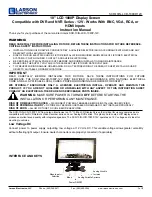
E-
31
English
ADDITIONAL
INFORMA
TION
AAAAA
■
Glossary
The following is a list of key words and their explanations used in
the use of projectors and image signals. Please refer to it when
using the DPX-1000.
DLP™ technology
This stands for Digital Light Processing. DLP uses the DMD
TM
chip, developed by Texas Instruments.
DCDi™ function
This is an abbreviation of Directional Correlational
Deinterlacing, a high quality image circuitry developed by the
Faroudja company. It uses edge cutting techniques to remove
jagged edges from images during Interlace
→
Progressive
conversion, allowing smooth, natural image reproduction.
Component video signal
Component video signal is sent with independent luminance
and color signals. It gives a higher image quality than ordinary
composite video signal because it bypasses mixing and
separating circuits. Component video signal consists of three
lines, the luminance signal (Y) and two color difference signals
(P
B
/C
B
, P
R
/C
R
).
S video signal
S stands for Separate. This signal is sent with separated
luminance (Y) and color (C) signals. Use a 4-pin mini DIN
connector and cable for connection.
Composite video signal
This is the most common type of video signal. The luminance
signal and color signal are sent combined in one line. Mixing
and separating processes are necessary on both the send and
receive sides. A pin cable is used for connection.
RGB signal
An RGB signal transmits color information by using a numeric
representation of the primary colors of red, green and blue
separately. When the signal is received, it can be expressed in
various colors by adding and mixing colors. This type of signal
is widely used for sending and receiving color images between
computers. Horizontal and vertical sync signals are also
necessary.
HDTV
This is an abbreviation of High-Definition Television, a term
used to define systems that satisfy the following conditions:
•
A vertical resolution of 720p, or 1080i (p stands for
progressive scans, i stands for interlace scans).
•
An image aspect ratio of 16:9
SDTV
An abbreviation of Standard Definition Television, used to
define normal television broadcasts which do not meet the
standards of HDTV.
Additional information
D connector
This connector is designed for the Japanese D format only.
It is used for sending and receiving the image signal between
the latest type of A/V components. This connector can receive
the component signal by using a D connector cable. There are
five levels (D1—D5) of performance characteristics. This unit
is compatible with D1, 2, 3, and 4.
DVI connector
A digital RGB/Component signal is sent differentially from a
computer or A/V equipment to this connector. A 24-pin
connector and cable are used.
Standby
The state in which the circuit to receive infrared-signals from
the remote control is activated but other main circuits are
turned off. A small amount of power is consumed in this state.
Test pattern
Test patterns are stored in this unit for use in adjusting the
position and focus of the projected image on the screen.
Interlace
The most common type of scanning in use in televisions. It
divides an image into two fields for scanning, and uses even
and odd numbered lines of those fields to build an image
(frame).
Progressive
This displays all the scanning lines of the entire frame at one
time. It greatly reduces the flicker that is more noticeable on a
larger screen to create a sharp and smooth image. This unit
projects using progressive scanning.
3-2 Pulldown detection style IP conversion
A function for directly converting interlace signal into sixty
frame progressive signal used when receiving 60 field interlace
signal from an image source recorded with the same 24 frames
as movie film. This allows DVD and other materiel recorded
with 24 frames to be projected on large screens as a natural,
precise image with no loss of quality, comparable to a movie
film.
SYNC
Computers output signals with a given regular frequency,
which the projector must be synchronized to in order to
produce a good quality image. Failure to match the phase of the
signal will result in flickering, fading, and distortion of the
image.
TRACKING
Computers output signals with a given regular frequency,
which the projector must be synchronized to in order to
produce a good quality image. Failure to match signal
frequencies will result in vertical striping in the image.
• DLP™ and DMD™ are trademarks of Texas Instruments.
•
is a trademark of Faroudja, a division of Genesis
Microchip Inc.
107_DPX-1000(E)31-39
03.2.19, 12:11 PM
31










































